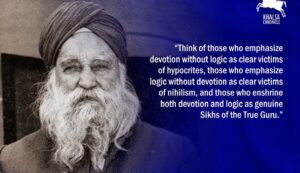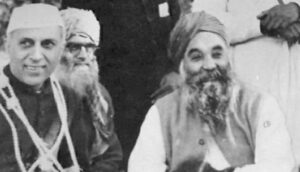Rajeev Puri

On November 22, 2024, India marked the 57th death anniversary of Master Tara Singh, a towering figure and a fearless leader who changed the course of the Partition with a kirpan and a cause. Yet, his contributions to the national cause remain conspicuously absent from most history textbooks. This is astonishing as it was his resolute efforts during the fraught years of Partition reshaped the subcontinent, securing Punjab’s division and ensuring the Sikh community was not left at the mercy of a theocratic Pakistan.
Today’s, Master Tara Singh remains the uncelebrated architect of Punjab’s partition. Born in Harial, Rawalpindi, on June 24, 1885, Tara Singh began his career as a school headmaster, earning the honorific ‘Master’ that would stay with him for life. Deeply rooted in Sikh faith and culture, he quickly rose through the ranks of the Shiromani Akali Dal, becoming one of its most influential leaders by the 1940s. His leadership coincided with one of the most turbulent periods in Indian history, as the Muslim League’s demand for Pakistan grew.
The 1940 Lahore Resolution, passed by the Muslim League, called for a separate homeland for Muslims, framing Hindus and Muslims as two incompatible nations. Punjab, with its Muslim majority (60 percent), was a key battleground for this demand. For the Sikhs, the stakes were personal and existential. Punjab was not only their homeland but also the cradle of their faith, containing sacred sites such as Amritsar’s Golden Temple. A united Punjab within Pakistan would have meant the marginalization — or worse, annihilation — of the Sikh community in a theocratic state.
While the Congress leadership dithered, tired from years of struggle and eager to negotiate a settlement, Master Tara Singh understood the dangers of such complacency. He was among the first to denounce the Pakistan Resolution, recognizing it as a direct threat to Punjab’s non-Muslim population. Congress leaders, absorbed in their broader negotiations with the British, took two years to mount a coherent response, leaving the Sikhs to fend for themselves in Punjab’s political arena.
Tara Singh’s resistance reached its zenith on March 3, 1947, outside the Lahore Assembly. The Unionist government under Sir Khizr Hayat Tiwana had just collapsed, paving the way for the Muslim League to dominate Punjab’s politics. In a tense atmosphere, amidst thousands of League supporters chanting “Pakistan Zindabad,” Tara Singh fearlessly brandished his kirpan and shouted “Pakistan Murdabad.” It was a moment of extraordinary courage, one that galvanized Punjab’s Hindus and Sikhs.
Realizing he was fighting an uphill battle, Tara Singh adopted the very logic used by the British and the Muslim League to justify Partition. If Muslims, constituting 30 percent of India’s population, could not live as a minority, he argued, then the 40 percent Hindu-Sikh population of Punjab could not be expected to do so either. By this reasoning, Punjab, like India, would have to be partitioned. His stance, coupled with mass demonstrations and protests, forced British to consider partition of Punjab.
The partition of Punjab, along with Bengal, was one of the most contentious aspects of Cyril Radcliffe’s mandate. Sir Cyril Radcliffe, a British lawyer with no prior experience of India and its complexities, was brought in to head the Boundary Commission. Arriving in India for the first time in July 1947, Radcliffe was given an impossible task: to carve out borders for the soon-to-be-created nations of India and Pakistan within just five weeks. His decisions would shape the lives of millions and leave a legacy of violence and displacement.
The division of Punjab was a particularly fraught process. Unlike Bengal, where linguistic divisions somewhat aligned with religious demographics, Punjab’s mixed population made any division deeply problematic. Many of Sikhism’s holiest sites, including Nankana Sahib and Panja Sahib, lay in the Muslim-majority areas that would become Pakistan.

The Radcliffe Award ultimately divided Punjab, with the Muslim-majority west going to Pakistan and the Hindu-Sikh-dominated east remaining in India. This decision, while devastating in its human toll, ensured that the Sikh community retained a homeland within India. Tara Singh’s insistence on partition was not about self-interest but survival; he foresaw the precarious existence Sikhs would face in a Muslim-majority Pakistan. Districts like Gurdaspur, crucial for linking J&K to India, were awarded to India, but others with mixed populations were arbitrarily split. The division uprooted nearly 15 million people, creating one of the largest forced migrations in history. For the Sikhs, the loss of ancestral lands and sacred sites in West Punjab was devastating.
Without Tara Singh’s advocacy, the Sikhs might have been left without a homeland, caught in a theocratic state that offered no guarantees of safety or equality. While Radcliffe’s mandate was to draw a ‘fair’ boundary, the reality was shaped by the ground realities that leaders like Tara Singh highlighted. His insistence on partitioning Punjab provided Radcliffe with a rationale for dividing a province that was otherwise destined for inclusion in Pakistan.
The ramifications of Tara Singh’s efforts extended beyond Punjab. He collaborated with Hindu Mahasabha leaders such as Syama Prasad Mukherjee and Lala Chandanmohan Chatterjee, who applied similar arguments to Bengal. Without their collective advocacy, the entirety of Bengal, like Punjab, might have been ceded to Pakistan.
Despite his monumental contributions, Master Tara Singh has been relegated to the sidelines of history. His efforts are acknowledged in international works such as Dominique Lapierre and Larry Collins’s Freedom at Midnight (recently made into a miniseries), Ishtiaq Ahmed’s The Punjab: Partitioned, Bloodied, and Cleansed, and Jaswant Singh’s Jinnah: India, Partition, Independence. Yet Indian history books remain curiously silent on his legacy.
Part of this neglect can be attributed to the uneasy relationship between Tara Singh and the Congress leadership. While he supported the nationalist movement, he often criticized Congress leaders for sidelining Sikh concerns. His direct, unyielding approach clashed with Congress’s broader strategy, leaving him isolated in the annals of history.
The geographical implications of his work are staggering. Without Tara Singh’s advocacy, the Indo-Pak border might have been drawn at Hodal, 58 kilometres from Mathura. Such a boundary would have left Amritsar, Ludhiana, and Chandigarh in Pakistan, fundamentally altering India’s territorial and cultural identity. Punjab’s partition was a tragedy in many respects, but for the Sikhs, it was also a lifeline.
Master Tara Singh’s story is not one of triumph alone but of foresight, resilience and sacrifice. His ability to navigate the treacherous waters of colonial politics, communal tensions, and international diplomacy remains unparalleled. His life serves as a reminder of the complex, often contradictory forces that shaped India’s Partition.
In hindsight, the tragedy of Partition could not be separated from its flawed execution, but figures like Tara Singh ensured that the Sikh voice was not lost in the cacophony. As we reflect on his legacy, we must ask why figures like Master Tara Singh remain uncelebrated in mainstream narratives. The absence of his name from history textbooks is not just an oversight; it is a disservice to the story of India’s independence.
Note – First published in – The Perfect Voice